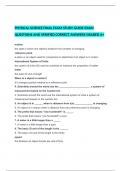Exam (elaborations)
PHYSICAL SCIENCE FINAL EXAM STUDY GUIDE EXAM QUESTIONS AND VERIFIED CORRECT ANSWERS GRADED A+
- Course
- Institution
PHYSICAL SCIENCE FINAL EXAM STUDY GUIDE EXAM QUESTIONS AND VERIFIED CORRECT ANSWERS GRADED A+ motion the state in which one object's distance from another is changing reference point a place or an object used for comparison to determine if an object is in motion International System of Units...
[Show more]



